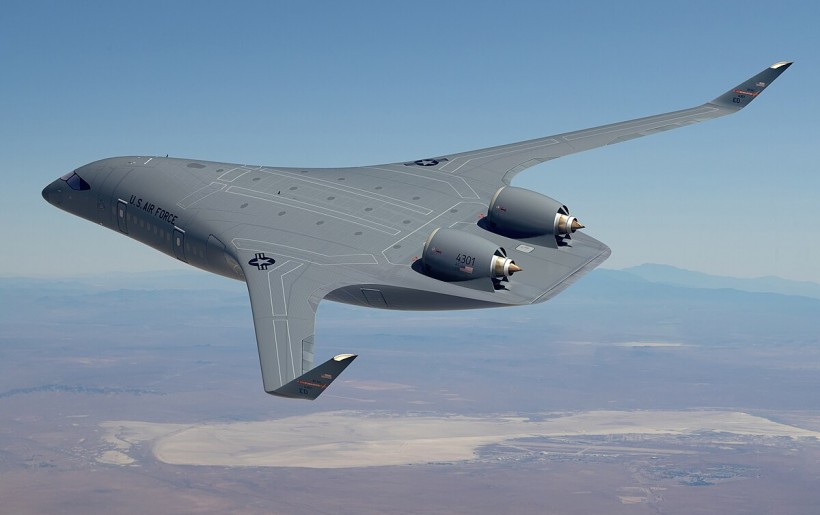In 2030, a futuristic jet featuring a 'blended wing body' design could potentially replace Boeing's problematic fleet. Recently authorized by the FAA, the Pathfinder, modeled after the B-2 Stealth Bomber, has a capacity of 250 passengers. It boasts an impressive range of 5,754 miles on a single tank of fuel, surpassing typical commercial aircraft. JetZero aims to slash fuel usage and emissions by 50% compared to other airlines.

(Photo : Wikimedia Commons/US Air Force)
Revolutionizing Aviation with Advanced Design
American airlines usually like to buy planes from Boeing, but Boeing has had some problems lately that prompted people to explore alternative options, potentially creating an opening for Pathfinder.
With the FAA granting certification to JetZero, the company is now poised to construct a full-scale model of the Pathfinder for test flights, marking a significant milestone in its development. This announcement, made last week, signifies that the prototype, a scaled-down version of the eventual demonstrator, is ready for experimental flights, fueled by a $235 million investment from the US Air Force aimed at building a commercial-sized Pathfinder by 2027.
Distinguished by its futuristic blended wing body (BWB) design, the Pathfinder deviates from conventional aircraft, drawing on aerodynamic advantages favored by the US military. Unlike traditional planes, the BWB seamlessly integrates wings into the main body of the craft, offering heightened performance and efficiency.
Crafted over decades of refinement by JetZero's founders, this innovative design employs stitched carbon fiber, a departure from traditional bolted metal, resulting in a lighter and more cost-effective aircraft.
READ ALSO: Rise in Severe Airplane Turbulence Linked to the Worsening Impact of Climate Change, Study Suggests
Pathfinder's Sustainable Design Enhances Efficiency
Pathfinder's advanced design not only offers aerodynamic benefits but also contributes to environmental sustainability. By eliminating the tail and extending the commercial jet's wings, JetZero has created a lighter-weight aircraft that reduces drag and consumes less fuel.
Tom O'Leary, JetZero's co-founder and CEO, highlighted the benefits of the blended wing, explaining how it merges pressurization and bending loads to enhance structural integrity. Moreover, the use of stitched carbon fiber as opposed to bolted metal renders BWBs cheaper to build and maintain, aligning with JetZero's vision to revolutionize aviation.
JetZero investor Tony Fadell emphasized the urgency behind creating JetZero, stating that it is essential for addressing climate goals amid an existential crisis. The company's carbon emission reduction target of 50 percent surpasses the advancements touted by NASA and Airbus, which aimed for a 20 percent reduction in fuel use.
JetZero's innovative design allows for the same seating capacity as standard widebody aircraft, maintaining passenger comfort without compromising legroom. This contrasts with domestic carriers like American, Delta, and United, which have reduced legroom over the years to accommodate more passengers.
O'Leary highlighted the versatility of JetZero's design, offering airlines the flexibility to enhance passenger comfort while reducing fuel consumption, ultimately challenging the industry's trend towards sacrificing comfort for economic gains.
Additionally, JetZero plans to develop three types of aircraft to cater to passenger, cargo, and military needs, addressing the pressing need for emissions reduction in aviation as global warming intensifies.
RELATED ARTICLE: Boeing 787-9 Dreamliner Nosedive Causes Chaos and Injuries on LATAM Flight to New Zealand; How Is It Possible?
Check out more news and information on Airplane in Science Times.




![Grown Mice With Hybrid Brains Can Smell Using Rat’s Neurons [Study]](https://1721181113.rsc.cdn77.org/data/thumbs/full/53431/89/56/50/40/grown-mice-with-hybrid-brains-can-smell-using-rat-s-neurons-study.jpeg)





!['Cosmic Glitch' in Einstein's Theory of General Relativity Could Be Explained in This New Scientific Tweak [Study]](https://1721181113.rsc.cdn77.org/data/thumbs/full/53435/258/146/50/40/cosmic-glitch-in-einsteins-theory-of-general-relativity-could-be-explained-in-this-new-scientific-tweak-study.jpeg)



